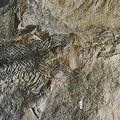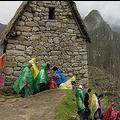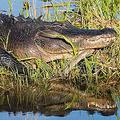 聯合國教科文組織世界遺產委員會(UNESCO's World Heritage Committee)年度會議上7月2日起展開,會議中除了審核各國政府提名列入新世界遺產的13個自然和34個文化景觀,也將根據考察評估,遴選出瀕臨危機的資產。2008年在加拿大舉辦的會議正好遇上魁北克400年建城紀念,而加拿大的喬金斯化石斷崖(The Joggins Fossil Cliffs)名列自然景觀的候選單中。
聯合國教科文組織世界遺產委員會(UNESCO's World Heritage Committee)年度會議上7月2日起展開,會議中除了審核各國政府提名列入新世界遺產的13個自然和34個文化景觀,也將根據考察評估,遴選出瀕臨危機的資產。2008年在加拿大舉辦的會議正好遇上魁北克400年建城紀念,而加拿大的喬金斯化石斷崖(The Joggins Fossil Cliffs)名列自然景觀的候選單中。
位於新斯科細亞省(Nova Scotia)芬地海灣(Bay of Fundy)前端的喬金斯化石斷崖,是在具有15公尺世界最高潮差的沖蝕下,所形塑出高23公尺的天然峭壁,隱於其中的化石也不斷地現蹤。
另外墨西哥中部的帝王蝶生態保護區(Monarch Butterfly Biosphere Reserve),也因其冬季上百萬蝶群從加拿大、美國遷徙而至的絕景而名列候選單,但帝王蝶渡冬的棲息區卻受到該地非法伐木者的破壞。
委員會也將考察30個世界瀕危遺產黑名單(the List of World Heritage in Danger),並考慮再加入更多迫切需要特別留意的世界遺產。
其中瀕危名單上的自然景觀,是經由國際自然保育聯盟(International Union for Conservation of Nature, IUCN)審查評估後,向世界遺產委員會推薦的。國際自然保育聯盟同時也報告了60處環境受威脅區域的保育情況,並在去年與教科文組織於某些地區施行聯合監管任務(joint monitoring missions)。
被列為受到嚴重威脅的現存世界遺產包括秘魯的馬丘比丘(Machu Picchu)古城遺址、厄瓜多爾(Ecuador)的加拉巴哥群島(Galapagos Islands)和剛果民主共和國的維龍加國家公園(Virunga National Park)。
 其中位於安地斯山印加古道深處的馬丘比丘古城,受到遊客過量入侵以及鄰近熱水城(Aguas Calientes)裡的遊客活動所造成的土石流、火災、建物坍方和健康危機等嚴重威脅,然而這些現象目前仍未喚起大眾意識,因此國際自然保育聯盟建議將此地列入瀕危的世界遺產。
其中位於安地斯山印加古道深處的馬丘比丘古城,受到遊客過量入侵以及鄰近熱水城(Aguas Calientes)裡的遊客活動所造成的土石流、火災、建物坍方和健康危機等嚴重威脅,然而這些現象目前仍未喚起大眾意識,因此國際自然保育聯盟建議將此地列入瀕危的世界遺產。
而2007年就在瀕危黑名單上的加拉巴哥群島,也因為持續受到大批遊客侵擾、非法捕魚與缺乏控管的物種過量移殖,包括山羊、豬、牛和上百種植物等外來物種的威脅而再度上榜。
在維龍加國家公園中建房居住的難民、武裝國民軍隊、為了生產非法炭而持續焚燒與濫墾林木等破壞現象,使維龍加自1994年起就未曾脫離瀕危名單,國際自然保育聯盟和教科文組織已規劃好相應的聯合監管任務。
其他現存的世界遺產,像是歐洲少有未受人類活動衝擊的地區西高加索山(the Western Caucasus),也因為2014年將在索契(Sochi)舉辦的冬季奧運而被列入受威脅的高危險群。
聯合監管任務也發現山上的滑雪中心與奧林匹克村,其賽事和相關活動、道路開闢以及非法伐林,也威脅著自然資源與邊境、野生動物的冬季覓食區和遷徙迴廊。
 而自1993年列為瀕危的美國濕地國家公園(Everglades National Park),雖然在去年已被世界遺產委員會從黑名單上刪除,國際自然保育聯盟今年仍然評估它持續遭受都市侵蝕、化肥、魚類和野生動物的汞污染、因防洪而水位下降等的嚴重威脅。
而自1993年列為瀕危的美國濕地國家公園(Everglades National Park),雖然在去年已被世界遺產委員會從黑名單上刪除,國際自然保育聯盟今年仍然評估它持續遭受都市侵蝕、化肥、魚類和野生動物的汞污染、因防洪而水位下降等的嚴重威脅。
The World Heritage Committee will consider the requests made by governments for inscription of 13 new natural sites on UNESCO's World Heritage List when it meets here Wednesday for its annual session.
During this year's meeting, hosted by Canada to coincide with the 400th anniversary of the founding of Quebec City, the committee will consider Canada's Joggins Fossil Cliffs among the 13 natural and 34 cultural sites proposed for listing in countries around the world.
The fossil cliffs of Joggins are located near the head of the Bay of Fundy in the province of Nova Scotia. This area is subjected to some of the world's highest tides, over 15 meters (49 feet). The tidal action causes steady erosion of the 23 meter (75 foot) high cliffs, constantly revealing new fossils.
Also under consideration is the Monarch Butterfly Biosphere Reserve in Mexico where millions of butterflies migrate for the winter from Canada and the United States. Illegal loggers have taken their toll of the forests where the monarchs winter.
The committee will also review the state of conservation of the 30 World Heritage sites inscribed on the List of World Heritage in Danger and may decide to add new sites to that list of properties whose preservation requires special attention.
IUCN, the International Union for Conservation of Nature, advises the Committee on which natural and mixed sites should be added to the List. Together with UNESCO, IUCN also reports on the state of conservation of some 60 sites under threat, a number of which received joint monitoring missions during the past year.
Existing World Heritage sites that are facing serious threats include Machu Picchu in Peru, the Galapagos Islands in Ecuador, and Virunga National Park in the Democratic Republic of Congo.
Machu Picchu, which lies at the end of the Inca Trail in the Andes, is threatened by high visitor numbers, a lack of control over their entry to Machu Picchu, and uncontrolled growth of the nearby town, Aguas Calientes.
There has been no public information about the very real threats of landslide, fire, building collapse and health risks associated with overnight stays in Aguas Calientes.
IUCN recommends this site is added to the list of World Heritage sites in danger.
Placed on the list of World Heritage sites in danger last year, the Galapagos Islands continue to face threats from the large numbers of tourists that visit each year, illegal fishing and high and unregulated immigration. They are also under threat from introduced species, including goats, pigs, cows and hundreds of species of plants. IUCN recommends the Galapagos Islands stay on the danger list.
Virunga National Park has been on the list of World Heritage sites in danger since 1994. It faces threats from refugees, who set up home in the park, armed militia, and continued poaching and deforestation, particularly for fuel and illegal charcoal production.
A joint monitoring mission by IUCN and UNESCO was organized.
Other existing World Heritage sites that will be reported on include the Western Caucasus, as one of the few large mountain areas of Europe that has not experienced significant human impact, but developments for the Sochi 2014 Winter Olympic Games pose a major potential threat to the site.
A joint IUCN and UNESCO mission found that the Sliding Centre for the luge and bobsleigh events, the mountain Olympic village, and related infrastructure, as currently proposed, would affect some areas within the property, the boundary of the property, and winter wildlife feeding grounds and migration corridors of wildlife from the property. Roads and illegal logging also pose threats.
Everglades National Park was removed from the list of World Heritage sites in danger last year, against IUCN's advice. It had been on the danger list since 1993 and in IUCN's opinion it still faces threats.
Urban encroachment, agricultural fertilizer, mercury contamination of fish and wildlife and lower water levels due to flood controls threaten the Everglades.
全文及圖片詳見:ENS



